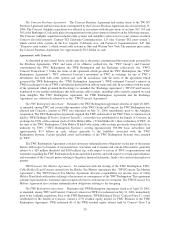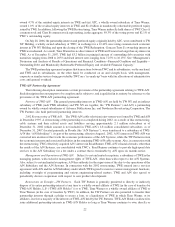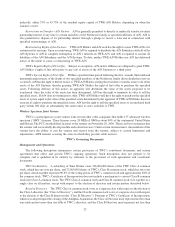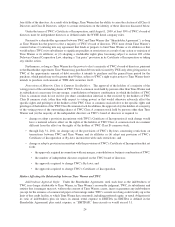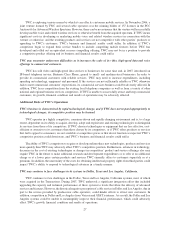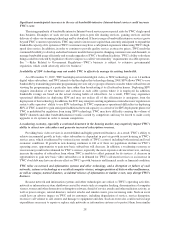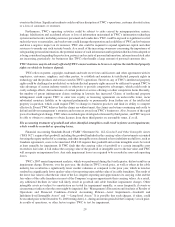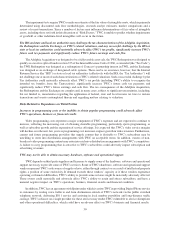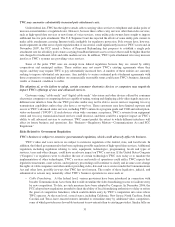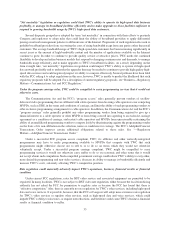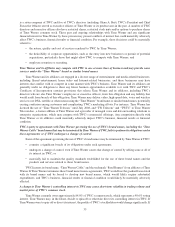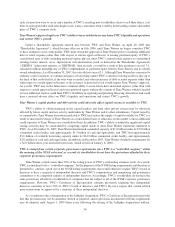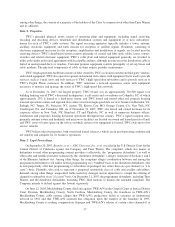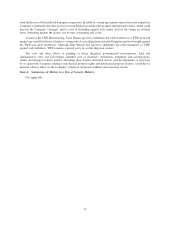Time Warner Cable 2007 Annual Report Download - page 34
Download and view the complete annual report
Please find page 34 of the 2007 Time Warner Cable annual report below. You can navigate through the pages in the report by either clicking on the pages listed below, or by using the keyword search tool below to find specific information within the annual report.events in the future. Significant incidents could result in a disruption of TWC’s operations, customer dissatisfaction,
or a loss of customers or revenues.
Furthermore, TWC’s operating activities could be subject to risks caused by misappropriation, misuse,
leakage, falsification and accidental release or loss of information maintained in TWC’s information technology
systems and networks, including customer, personnel and vendor data. TWC could be exposed to significant costs if
such risks were to materialize, and such events could damage the reputation and credibility of TWC and its business
and have a negative impact on its revenues. TWC also could be required to expend significant capital and other
resources to remedy any such security breach. As a result of the increasing awareness concerning the importance of
safeguarding personal information, the potential misuse of such information and legislation that has been adopted or
is being considered regarding the protection, privacy and security of personal information, information-related risks
are increasing, particularly for businesses like TWC’s that handle a large amount of personal customer data.
TWC’s business may be adversely affected if TWC cannot continue to license or enforce the intellectual property
rights on which its business depends.
TWC relies on patent, copyright, trademark and trade secret laws and licenses and other agreements with its
employees, customers, suppliers, and other parties, to establish and maintain its intellectual property rights in
technology and the products and services used in TWC’s operations. However, any of TWC’s intellectual property
rights could be challenged or invalidated, or such intellectual property rights may not be sufficient to permit TWC to
take advantage of current industry trends or otherwise to provide competitive advantages, which could result in
costly redesign efforts, discontinuance of certain product or service offerings or other competitive harm. Recently,
the number of patent infringement claims resulting in lawsuits has increased. Claims of intellectual property
infringement could require TWC to enter into royalty or licensing agreements on unfavorable terms, incur
substantial monetary liability or be enjoined preliminarily or permanently from further use of the intellectual
property in question, which could require TWC to change its business practices and limit its ability to compete
effectively. Even if TWC believes that the claims are without merit, the claims can be time-consuming and costly to
defend and divert management’s attention and resources away from TWC’s businesses. Also, because of the rapid
pace of technological change, TWC relies on technologies developed or licensed by third parties, and TWC may not
be able to obtain or continue to obtain licenses from these third parties on reasonable terms, if at all.
The accounting treatment of goodwill and other identified intangibles could result in future asset impairments,
which would be recorded as operating losses.
Financial Accounting Standards Board (“FASB”) Statement No. 142, Goodwill and Other Intangible Assets
(“FAS 142”) requires that goodwill, including the goodwill included in the carrying value of investments accounted
for using the equity method of accounting, and other intangible assets deemed to have indefinite useful lives, such as
franchise agreements, cease to be amortized. FAS 142 requires that goodwill and certain intangible assets be tested
at least annually for impairment. If TWC finds that the carrying value of goodwill or a certain intangible asset
exceeds its fair value, it will reduce the carrying value of the goodwill or intangible asset to the fair value, and TWC
will recognize an impairment loss. Any such impairment losses are required to be recorded as non-cash operating
losses.
TWC’s 2007 annual impairment analysis, which was performed during the fourth quarter, did not result in an
impairment charge. However, over the past year, the decline in TWC’s stock price, as well as others in the cable
industry, has resulted in a significantly lower market valuation as compared to the prior year, which in turn has
resulted in a significantly lower market value of its reporting units and the value of its cable franchises. The result of
the lower fair values is that the fair value of the Los Angeles reporting unit approximates its carrying value and the
fair values of the cable franchises in most of the Company’s regions approximate their carrying values. As a result,
any additional declines in value will likely result in goodwill and cable franchise impairment charges. Other
intangible assets not subject to amortization are tested for impairment annually, or more frequently if events or
circumstances indicate that the asset might be impaired. See “Management’s Discussion and Analysis of Results of
Operations and Financial Condition—Critical Accounting Policies—Asset Impairments—Goodwill and
Indefinite-lived Intangible Assets” and “—Long-lived Assets.” It is possible that such charges, if taken, could
be recorded prior to the December 31, 2008 testing date (i.e., during an interim period) if the Company’s stock price,
its results of operations, or other factors require TWC to test for impairment.
29



